Medieval Chinese Buddhist cave temple sites—complexes of caves carved into mountainsides or rocky riverbanks as religious shrines—are important repositories of religious sculptural art. Unfortunately, many currently exist in severely damaged condition. The Xiangtangshan Caves Project began in 2004 with multifaceted research and information gathering, involving study of the historical site and historical texts, tracking of sculpture fragments around the world, and digital capture (both 2D and 3D) of objects and cave sites. The work produced digital reconstruction of the caves that were shown in an innovative exhibition, Echoes of the Past: The Buddhist Cave Temples of Xiangtanshan, which traveled in the U.S. from 2010–2013, and incorporated actual sculptures from the sixth-century cave shrines in conjunction with digital installations. For more about the exhibition, visit the Smithsonian and Smart Museum exhibition pages, or view the exhibition catalog. To view sculptures from the caves, visit the Xiangtangshan project website below.
An addendum to the project digitized the historical engraved stone inscriptions at Xiangtangshan.With collaboration of the Taiyuan University of Technology School of Art and the Fengfeng Cultural and Travel Bureau, the project is being extended to include 3D scanning of the caves and virtual restoration of the caves in combination with digital 3D models of the sculptures in collections outside China.


